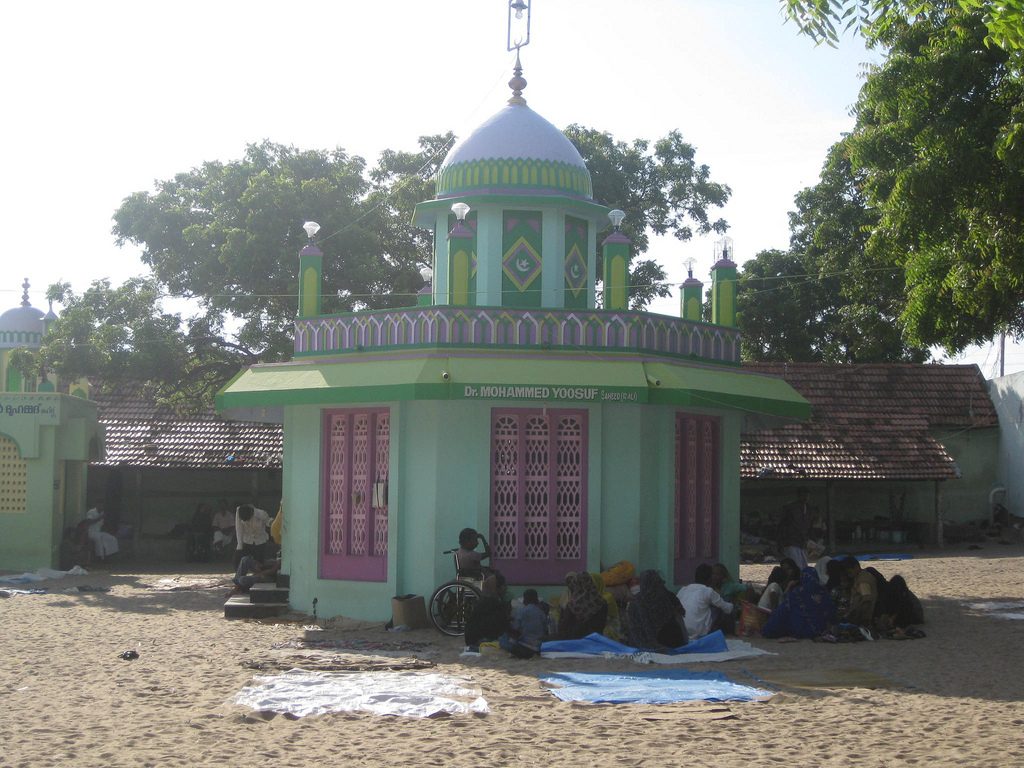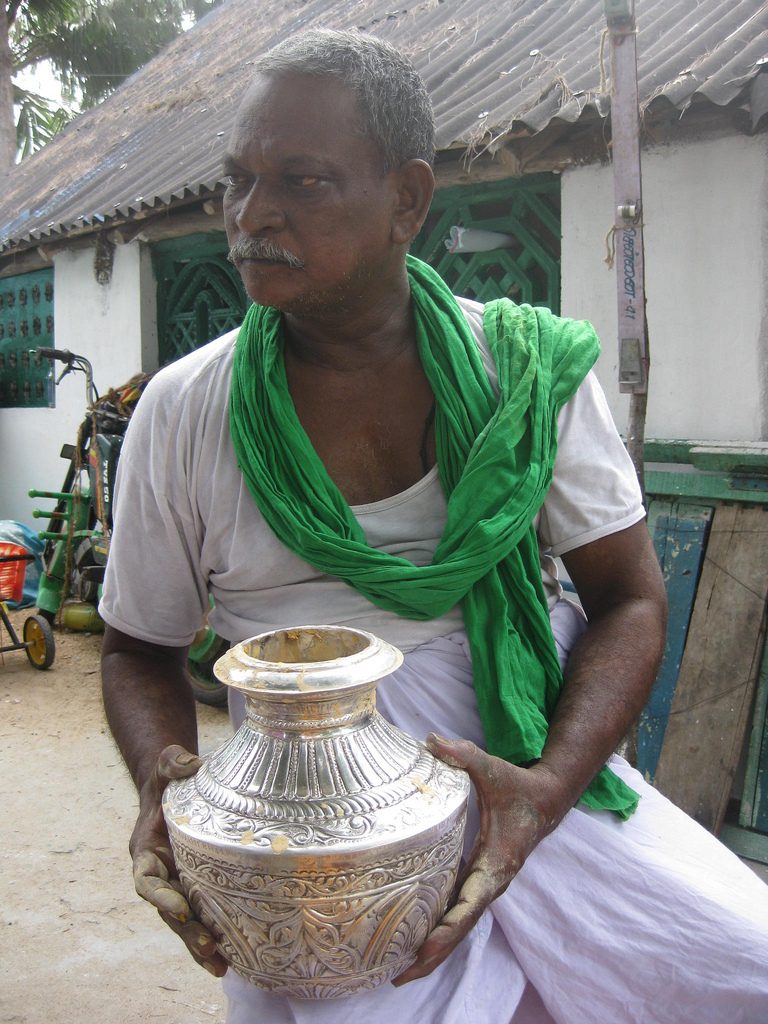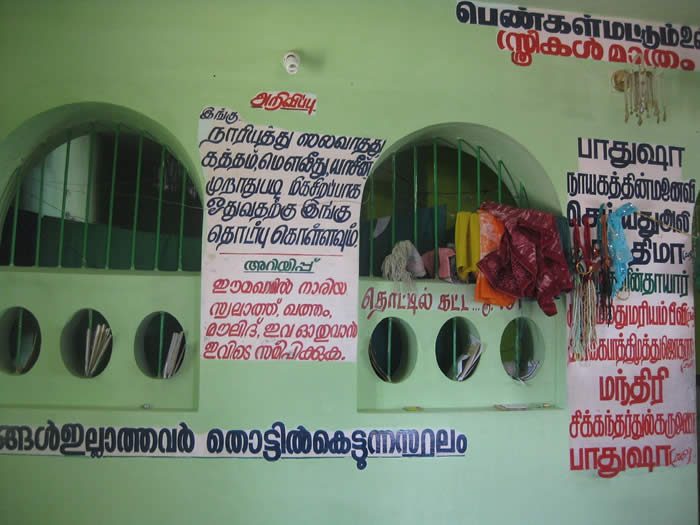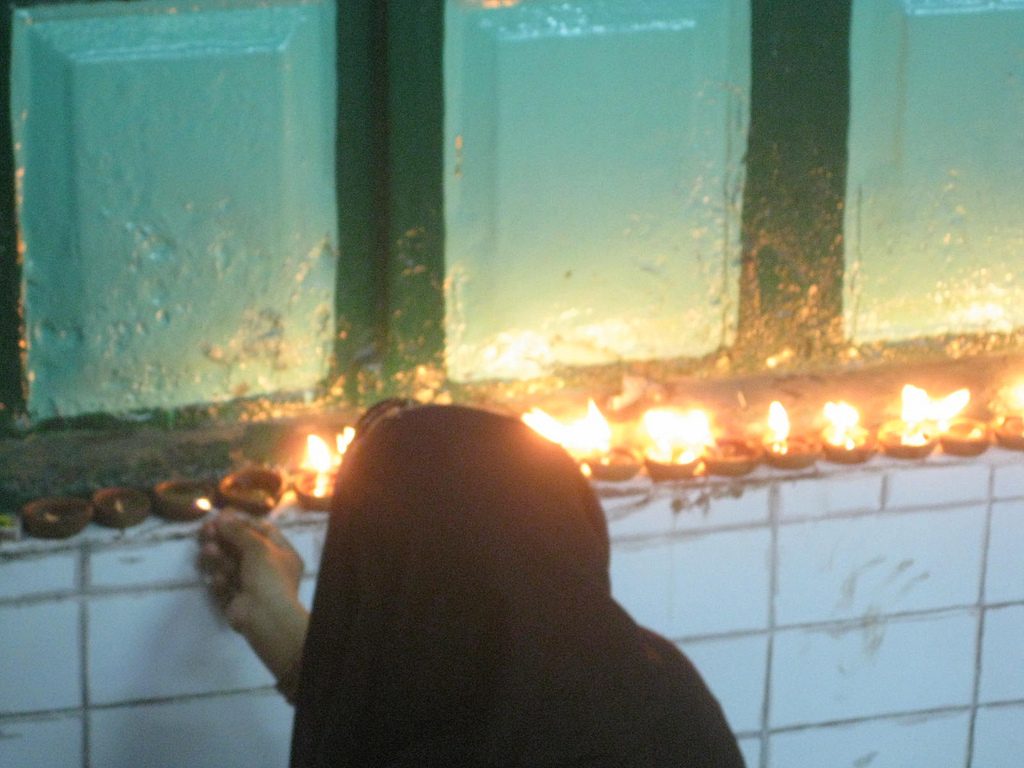Karen De Looze
Belgium
 |
|
Ervadi Dargah |
Understanding mental health care in an Indian context involves a long and adventurous exploration of faith healing. In India, people who suffer from mental illness frequently employ faith healing as an alternative to psychiatric treatment (Raguram et al. 2002). Faith healing often takes place in the temple of a Hindu deity and can even occur at a Dargah, which is a shrine built over the grave of a Sufi Muslim saint. In fact, the community of Hindu patients that I interviewed over the course of my research seemed to frequent both temples and Dargahs in significant numbers in search of all kinds of healing—although healing of mental illness may well be the most solicited. While Muslim healers open their holy sites to people from all religions and Hinduism welcomes the worship of all deities from all spiritual paths, Hindus tend to appeal to Muslim ritual within the Dargah—in addition to their own traditional temples—primarily in periods of illness. Thus in India, the brotherhood of sickness may be far more inclusive than the brotherhood of health (Kakar 1982).
Temples and Dargahs sometimes collaborate with mental health institutions, but delineating where mental health diagnoses overlap with their descriptions in the temples and Dargahs presents a challenge. Contrasting with medical psychiatric diagnoses, mental health diagnoses in places of faith healing include spirit possession, black magic, or evil spells. For instance, Mansoor, a hereditary trustee of a Dargah located in Chennai, explains:
The abnormality is something like being restless. When we see a person, we’re able to identify whether this person is in good health, with which I mean a good mind or good consciousness. That person [i.e., the one who is restless] will not behave normally. He will try to distract himself. He will constantly shake his head. His eyes will become fierce and his body will gain strength. If you try to catch him he will give you a push of ten humans. . . . His eating abilities will be quite abnormal too; he will eat what ten humans can eat because he is not the one who eats. It is a bad spirit in him that eats. . . . He will behave in the most harmful way to the common man. (Syed Mansooruddin, pers. comm.)
 |
|
A healer Karen De Looze |
Alauddin, now a healer and a keeper of a Dargah in Kovalam, had accompanied his wife for healing years before. Similar to Mansoor, he describes her previous complaint: “Someone cast a spell on her. The one who cast the spell and I were not on good terms. He tried to attack me, but I was in my good times [nalla neram]. I was safe. In turn, he victimized my wife” (Alauddin, pers. comm.). When asked to elaborate on what he meant by “good times,” he responded, “This is assessed in relation to the eclipses [grahanam] as per the horoscopes. It’s believed that no evil/bad things could possibly attack you if you are in this good time, but it surely will if you are in your ‘bad time’ [ketta neram]” (Alauddin, pers. comm.).
In Sanskrit, graha is the word for planet, but it can also represent a spiritual force that influences or takes control of another organism (De Fouw and Svoboda 2003). On the other hand, vidyas are sometimes described as goddesses who “possess” a devotee. Both exert influence, but the influence of the graha tends to be negative, while possession by a vidya can lead to healing:
Like vidyas, the grahas grasp and possess you, but they do so in ways which are usually less pleasant and productive than are possessions by vidyas. A graha grabs hold of your being with its emanations and directs you . . . to perform particular actions that you might not otherwise perform, in pursuit of goals which may not agree with your personal dharma. (De Fouw and Svoboda 2003, 33)
 |
|
Taking blessings at a saint’s tomb Karen De Looze |
In Vedic astrology, all factors of an individual’s horoscope must be analyzed to gain insight into the individual’s mind (De Fouw and Svoboda 2003; Kapur 1979). The influence of Saturn for example often signals a “bad time,” where an individual is more easily influenced by other grahas. The moon also influences the mind and aggravates the experience of possession. Therefore, on full and new moon days the centers of faith healing find particular popularity. Alauddin explains:
In the Hindu society, only on full and new moon days, the ghosts will make people dance agitated. . . . Because these are the special days for them. When I say special days, it means that the magicians work on full and new moon days on the people. Like the pyre that is set during weddings, the magicians use them during those days to work on people. If he does black magic on a person this month for the first time, then he does pooja [a ritual] on them the next month. He will keep on doing pooja every full moon and new moon day on the victims’ names. It is that time of the month that the spirits become angry and agitated. (Alauddin, pers. comm.)
Like mental illness, mental health is achieved through the act of “possession.” In faith healing centers, the patient fosters a personal relationship with a deity—for example Veerabadhrar in Hanumanthapuram—and a patients’ circumambulation of the temple center is often part of the “treatment.” Although the healing may well lie in the act of devotion, certain deities may be more helpful than others in certain situations, depending on the qualities they represent and will therefore manifest within the patient. In India, this devotional relationship restores a patient’s free will, usurping the power of the grahas (De Fouw and Svoboda 2003). Even more, a true devotee may acquire the ishta ball, or the strength of the deity. From the Hindu mindset, focusing one’s mind on a personal deity, at the very least, attunes the mind to a larger, more positive energy that permits the patient to escape his negative thought patterns. In Dargahs, like in temples, the patient directs the mind to a devotional relationship with the saint. The saint may then bestow on a person the grace and blessings of God (see fig. 3), thereby mitigating the effect of the grahas (De Fouw and Svoboda 2003). Mansoor says:
See, the treatment is not of the body. The body of the person into whom the jinn [one kind of spirit] has entered is healthy. It [the treatment] is only the warding away of the jinn from interfering with the human’s attachment with the human soul. . . . So the treatment that has to be done is of warding off the bad soul from the human soul. . . . It is not of the destruction of the human body. It is only [a treatment of] the soul, since the soul is being superimposed by a bad soul. (Syed Mansooruddin, pers. comm.)
 |
|
Prayer flags and letters
Karen De Looze |
In Indian philosophy, each deity represents Universal Consciousness, Soul, or one Self—the unchanging reality that is veiled by the world (and from which the world itself is derived). As such, in worship, one indirectly worships the singularity hidden behind the mask of the deity’s personality, which is grounded in the world. The person who calls on faith healing thus moves beyond his or her own personality, or worldly self, to surrender to and discover his or her true Self in the deity: “The only sure sign of this [surrender] is, that our mind gets calm and peaceful” (Nagesh 1991, 235). After all, the deity and the Soul are one and the same (Nagesh 1991). It is therefore not surprising that many patients, once possessed by grahas, become healers once they are possessed by a vidya. As a healer told me:
When God enters me, I find out who are all sick and affected by evil spirits and ghosts. Each time people come with a problem, I talk to God who enters me. She tells me that “they have got this problem and they are not well”; “this family has got this problem,” like that she tells me and I tell them. When they pray to God, God tells me they’ll be cured or their problem reduced. (Anonymous, pers. comm.)
The essence of faith healing seems to restore the connection between the mind and soul so that the mind can sunbathe in the light of the latter. As such, faith healing distinguishes itself from medical approaches in curing mental illness. In the West, doctors may try to reestablish the ego as an integrated whole, but faith healing redirects the mind away from the ego. Yet, some argue that the crux of the differentiation lies not in a distinction between East and West, but rather involve subcultures in both:
 |
|
A woman lighting a lamp in a Dargah Karen De Looze |
[T]he line of cleavage in the healing professions and among different healers is not simply between traditional and modern or between Western and Asian, or between healers belonging to different cultures. The real line of cleavage, cutting across cultures and historical eras, seems to be between those whose ideological orientation is more toward the biomedical paradigm of illness, who strictly insist on empiricism and rational therapeutics and whose self-image is close to that of a technician, and others whose paradigm of illness is metaphysical, psychological, or social, who accord a greater recognition to arationality in their therapeutics and who see themselves (and are seen by others) as nearer to the priest. (Kakar 1982)
Concerns about acknowledging the efficacy of faith healing (Raguram et al. 2002) frequently cite fears that this might “leave unwary patients with an unjustifiably favorable impression that healing temples can cure their diseases” (Kalantri 2002). Many also believe that faith healing should be integrated into a more a holistic approach to mental health care. Such an approach would include cultural and anthropological perspectives on the internal logic of faith healing (Raguram et al. 2002; Shankar, Saravanan, and Jacob 2006), of which this article has offered a mere glimpse.
Acknowledgements
Many thanks to Ms. Porkodi, Mirjam Dijkxhoorn, and the entire staff at the Banyan for providing entry into this difficult yet exciting research topic. Thank you, Oscar Van Keulen, for many joyful moments as we undertook this study together. Brindaa Lakshmi, Mani Rajendiran, and Sindhoo Rangarajan: without your wonderful work of translation this study would never have been possible. Last but not least, my heart goes out to Vaishnavi Sundararajan, Raji Lakshmi, and her husband Lakshmikant, Dhanuja Subaash, and Prameela Pria for undertaking the hard work of transcribing and translating research tapes. Thank you so much, all of you!
References
- De Fouw, Hart, and Robert Svoboda. 2003. Light on life: An introduction to the astrology of India. Twin Lakes: Lotus Press.
- Kakar, Sudhir. 1982. Shamans, mystics and doctors: A psychological inquiry into India and its healing traditions. Chicago, IL: University of Chicago Press.
- Kalantri, S. P. 2002. Healing temples may breed superstitions. British Medical Journal. (August 3) http://www.bmj.com/content/325/7354/38/reply (accessed July 12, 2002).
- Kapur, R. L. 1979. The role of traditional healers in mental health care in rural India. Social Science and Medicine 13B: 27–31.
- Nagesh, Vasudev Gunaji. 1991. Shri Sai Satcharita or the wonderful life and teachings of Shri Sai Baba. Bombay: Shri Sai Baba Sansthan.
- Raguram, R., A. Venkateswaran, J. Ramakrishna, and Mitchell G. Weiss. 2002. Traditional community resources for mental health: A report of temple healing from India. British Medical Journal 325: 38–40.
———. 2002. Author’s response. British Medical Journal. (August 12) http://www.bmj.com/content/325/7354/38/reply (accessed July 13, 2011). - Shankar, B., B. Saravanan, and K. S. Jacob. 2006. Explanatory models of common mental disorders among traditional healers and their patients in rural South India. International Journal of Social Psychiatry 52: 221–233.
KAREN DE LOOZE, MS, is a PhD researcher working for the Interdisciplinary Center Leo Apostel at Brussels Free University in Belgium. She has a bachelor’s degree in educational science, a master’s degree in social and cultural anthropology, and credentials in culture and development studies. She has worked as an anthropologist with diverse groups, such as the First Nations of North America as well as various ethnic groups from Tanzania, Latin America, and Asia. The interviews included in this article were conducted as part of Karen’s current research in faith healing temples in Hahnumanthapuram, Bihar, Vellalapatti, Gunaseelam, and Chennai, and in Dhargas in Bombay, Chennai, Kovalam, and Ervadi. To learn more about Karen’s work, please go to www.vub.ac.be/clea/people/delooze.
Highlighted in Frontispiece Fall 2011 – Volume 3, Issue 3

Leave a Reply